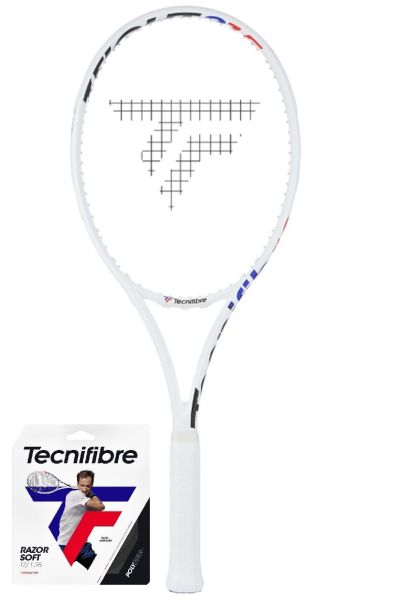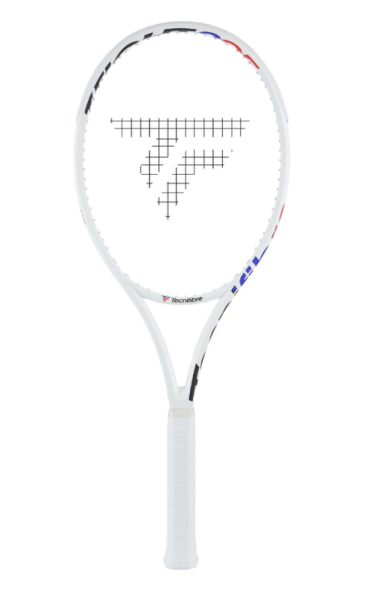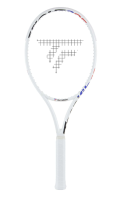Recommended retail price
Tecnifibre T-Fight 280 Isoflex
The Tecnifibre T-Fight 280 Isoflex is an excellent choice for intermediate players, designed to deliver a high level of stability and maneuverability, ensuring superior shot precision. Developed with the Isoflex system and cushioning Foam, this racket provides optimal power and playing comfort. Its frame, characterized by higher stiffness (68 RA), contributes to the racket's performance attributes.
String Pattern and Balance
Featuring a 16/19 string pattern along with a mid-balance weighting system, the T-Fight 280 Isoflex creates a perfect blend of dynamism and precision. This weight balance ensures significant stability and control over strokes when performing a full swing. What’s more, the larger swing weight bolsters the kinetic energy on clean hits, making your strokes more effective.
Advanced RSL Section Technology
This racket boasts the innovative RSL Section technology, specifically engineered for superior performance. The Tecnifibre T-Fight 280 Isoflex is constructed with graphite material to assure you of its longevity and robustness.
| Product number: | ST89374.1 |
| Racket series: | T-Fight |
| Weight: | 280 ? more |
| Head size (cm2): | 645 ? more |
| Balance: | 325 ? more |
| String pattern: | 16/19 ? more |
| Stiffness (RA): | 68 ? more |
| Lenght: | 68,5 ? more |
| Beam profile: | 23/23/23 ? more |
| String tension (recommended in kg): | 22-25 ? more |
| Material: | grafit |
| String: | no |
| Cover: | no |
| Dampener: | no |
| Technologies |
RS SECTION
Isoflex
|
How to choose an adult racket
A tennis racket is usually rarely bought, once in a few years, for several years, and often for the first time in life. During this time, technologies used in the production of rockets are changing dynamically. Many racket parameters affect the pleasure and progress in the game of tennis. Descriptions of the main parameters of the rocket should be located on its frame (in different places). However, they are often difficult to read, especially for novice players. In order to facilitate the appropriate selection of the racket and understanding its parameters, we present below the main features that you should pay attention to when buying a racket, so that it is most accurately matched to the individual predispositions of the player.
Head (size) and shape of the head
Rackets have different shapes and different sizes of heads. When it comes to the shape of the head, there is no clear assessment of what shape is ideal and recommended for the appropriate group of players. Most of the heads are in the shape of a "classic egg". There are clearer classification rules for the size of the racket head. The size of the racket head is given in centimeters and / or square inches and refers to the surface area. The surface of the racket head is responsible for the force and precision of the strike.
There are three basic sizes of racket heads:
- Midsize (small) - 85-93 square inches
- Midplus (medium) – 94 – 103 square inches
- Oversize (big) – above 104 square inches
Summarizing, it can be assumed that:
- Beginners - should pay attention to heads with a size from 660 cm2 (102 square inches)
- Intermediate people - heads of size 645-690 cm2 (100-107 square inches)
- Advanced people - individual selection, but rather, these are heads with an area 645 cm2 (100 square inches) i mniejsze.
Racket length
The length of the racket is the distance from the base of the handle to the end of the racket head. The standard adult racket is 68.58 cm (27 inches) long, by far the most on the market. Extended rackets (even by a few centimeters) increase the range and strengthen the force of impacts, as well as provide better service and ball rotation. Instead, they reduce ball control. The lower maneuverability of the extended rackets is especially noticeable when playing at the net. Standard rockets are more dynamic. Shorter lengths than the standard ones are junior rackets. The physical conditions of the child are an important factor in the selection of rackets for children. The height and weight of a child may contribute to the fact that physically grown children should use rackets a little longer than recommended by the manufacturer.
Division of rackets due to length:
- 27 inches (68.58 cm) and larger - for adult tennis players
- 26 inches (66 cm) - for children 10-12 years or 136-146 cm
- 25 inches (63.5 cm) for children 8-10 years or 128-136 cm
- 23 inches (58.5 cm) - for children 6-8 years old or 120-128 cm
- 21 inches (53.5 cm) - for children 5-6 years old or 112-120 cm
- 19 inches (48.5 cm) - for children 4-5 years or 100-112 cm
Racket weight
This is a very important factor in choosing the right racket. The weight of the racket for an adult player may vary between two hundred and three hundred grams.
Summarizing, it can be assumed that:
- Beginners - should look for lighter rackets weighing 270-290 grams (men), 250-270 grams (women),
- Intermediate people - should pay attention to rackets weighing 280-300 grams,
- Advanced people - choose rockets that exceed three hundred grams with the option of individual "weighing" of the rackets through the use of lead tapes attached to the frame.
Racket balance
The balance of the racket is the center of gravity of the racket. It is measured in centimeters from the shoe to the tip of the head. In this respect, the rackets can be divided into: balanced on the head - HH (head heavy), balanced on the handle - HL (head light), balanced evenly - EB (even balance). Two rackets with the same weight but differently balanced give a completely different feeling when playing. Rockets with a center of gravity shifted towards the handle have a lighter head and are more maneuverable. They are great to play with the net. Head-balance rackets usually belong to the group of light rackets. By shifting the center of gravity towards the head, the player can spend less energy to deliver a strong hit. These types of rackets allow for a dynamic "swing" during the game. Rather, they are intended for beginners. Center-balance rackets have an evenly distributed weight. They offer the player a balanced power and impact control. Handlebar balance rackets are rather heavy rackets. Their head is lighter. This translates into a less dynamic "swing" but better controlled strokes. These types of rackets are most often chosen by advanced players.
Swingweight rackets
Swingweight - weight sensation throughout the entire strike cycle. This parameter depends on the mass of the rocket, balance and aerodynamics (including the size of the head). And the selection in terms of this parameter depends on the physical build and strength of the player:
- strong, athletic player - high swingweight
- medium build - average swingweight index
- weak, flimsy build - low swingweight
Racket frame stiffness
Racket stiffness, which is how much the frame deforms when it contacts the ball, is measured in RA units. Stiffer rackets allow for a stronger impact, but more shocks are transferred to the wrist. Flexible rackets give you more ball control and put less strain on your wrist.
The division of rackets due to the flexibility of the rocket frames:
- flexible frames <60 RA - less impact force, less vibration on the wrist
- medium flexibility of the 60-69 RA frame - a compromise between flexible and stiff
- stiff frame> 70 RA - greater impact force, more vibration transfers to the wrist
Profile (thickness) of the racket frame
Rocket frames have different thicknesses. There are those that have the same thickness along the entire length, while the thickness of others is variable. You can classify the racket frames according to the frame profile into three groups: thin, medium and thick:
- Thin frames <23mm - lots of feel and less strength and damping. Rackets with a rather small head area, heavy. For advanced players with a full swing.
- Medium frames 23-25 mm - universal, closer to 23 mm for advanced players and closer to 25 mm for beginners, tennis players with a medium swing.
- Thick frames> 25 mm - low feeling, a lot of own power, for short swing play For beginners with poor technique, older tennis players with minor hand injuries. These are usually rockets with advanced vibration reduction systems during impact.
Racket design
Until a few decades ago, wood was used to produce rockets, with time aluminum. The main disadvantage of these rackets was their weight, which made maneuvering difficult and at the same time easy to play and led to frequent injuries. With time, tennis equipment production technologies were improved.
Currently, the production of tennis rackets is used:
- aluminium
- graphite composites (graphite, i.e. carbon fiber, with an admixture of aluminum)
- pure graphite
- graphite with admixtures of materials such as kevlar, boron, titanium
Aluminum rackets are the most flexible, but also heavy and transfer a lot of vibration to the wrist. That is why they are not very popular among players who prefer to choose rackets made of graphite composites, made of graphite only, or with the aforementioned additional materials (boron, kevlar), which make the racket light and durable. Tennis racket manufacturers have their own trade names for the materials and technologies used in racket production.
The arrangement of strings (tension) of the racket
The most popular arrangement of strings is the arrangement (vertical / horizontal ratio): 18/20 and 16/19. There are also other layouts such as: 18/19, 16/18, 14/18 and others. Due to the density of the string arrangement, there are two basic arrangements: open "open" (a rare arrangement of strings, e.g. 16/19) and closed "close" (dense 18/20 string arrangement)
The string system (tension) is open
- more ball power but less control,,
- greater deformation of the impact surface,
- gives the ball more spin because the ball has more contact with the tension,
- they have a negative effect on the durability of the string (due to the easy movement of the strings in the racket, they are rubbed faster),
- lower "stiffness of the string system,
- larger "sweet spot" - clean hit field,
Closed string system
- less strength and more control,
- less deformation of the surface of the impact of the racket and thus lower dynamics of the game,
- longer string life (you need to replace it less often because it has a lower tendency to break). This is due to the fact that the "dense" string cannot move relatively freely,
- less "rotation"
- smaller "sweet spot" - clean hit field
Recommended tension force
Racket manufacturers provide the recommended tension force, measured in kilograms, with which they recommend stringing rackets with a tolerance of +/- 2 kg. Tighter strings in the racket give more control of the ball, but reduce strength, dynamics and rotation. Increasing the string tension also makes the game less comfortable, as more adverse effects from hitting the ball will be transmitted through the racket frame to the player's body generally. Weaker racket string tension reduces ball control (the catapult effect is often cited). However, we will achieve greater dynamics of strokes and rotation, because the ball stays on the strings longer and "bites" more into the racket.
Racket handle size
An important detail is the appropriate adjustment of the size (circumference) of the racket handle to the player's hand. There should be markings on the size of the racket handle on the racket. The American method specifies the handle circumference in numbers from 0 to 5 (often the letter L or G is added), while the English method specifies the handle circumference in inches from 4 to 4 and 5/8 inches. Size L (G) 0 is 4 inches, L (G) 1 - 4 (1/8 inch), L (G) 2 - (4 1/4 inch), L (G) 3 - (4 3/8 inch) ), L (G) 4 - (4 1/2 inch), L (G) 5 - (4 5/8). The correct grip is when the index finger of the other hand is between the ball of the thumb and the fingertips of the racket holder. The most popular handle sizes are L (G) 3 and L (G) 4. Small women should choose a handle size - L (G) 1. Teenagers, women and men with medium and short stature (rather short fingers) should choose handle size L (G) 2 and tall people (with long fingers) - L (G) 4 or L (G) 5. When we are not sure whether to choose, for example, handle 3 or 4, remember that it is always safer to buy a racket with a thinner handle and possibly thicken it it with a wrapper, the so-called overgrip. The Head company was the first to use the so-called "interchangeable handles" so that you can thicken or slim down the racket handle depending on your needs.
Summary
There are several dozen manufacturers of tennis rackets known on the market, producing several hundred models of tennis rackets. Every year, new rocket models with new technologies and new, fashionable colors appear on store shelves. However, the rules for selecting rockets, especially for beginners, for whom it is often the first rocket in their life, can be simplified. This is an important choice because the selection of the right racket will partly depend on whether you like tennis and become a way of spending your free time. Based on the characteristics of the rocket parameters described above, beginners should be guided by the following guidelines when choosing a rocket:
- large heads exceeding 660 square cm (or 645 cm square)
- standard length, i.e. 68.58 cm or slightly extended (1-2 cm)
- light rackets not exceeding 280 grams
- balance on the head of the racket, i.e. above 34-35 cm
- low swingweight (weight sensation during the entire bump cycle)
- rather hard frame (above 70 RA) or medium flexible (60-69 RA)
- racket frame profile approximately 25 mm or greater
- frame structure enriched with admixtures of graphite composites and other modern, light, durable materials with technologies enabling the shock absorption of vibrations during impact
- open string arrangement - a rare arrangement of strings
- recommended tension force as recommended by the manufacturer, medium or below average
- individually fitted handle (we remember that the correct grip is one when the index finger of the other hand is placed between the ball of the thumb and the fingertips of the hand holding the racket)
Grip is a tennis racket part held by a tennis player. The size of the grip defines its circumference. At the beginning of tennis adventure, we often have problems with choosing the proper size of the grip. Bellow we will present you a solution to this problem.
|
american markings |
european markings |
| 4 / ≈ 10 | 0 |
| 4 1/8 / ≈ 10,4 | 1 |
| 4 1/4 / ≈ 10,8 | 2 |
| 4 3/8 / ≈ 11 | 3 |
| 4 1/2 / ≈ 11,4 | 4 |
| 4 5/8 / ≈ 11,8 | 5 |
You won’t find grip size markings in centimetres. To make it easier, we converted inches to centimetres, to help you choose the right size. It will be useful for you when you are unable to try the racket in the shop, e.g. when you want to buy a racket in the online store.
Information about the size of the grip is usually located on its bottom. Size of the grip is very important, however in contrast to the head size, not because different sizes give different effects during the game. Grip circumference must be precisely matching players hand size, only then the player may be sure that his grip will be firm, the racket will be stable in their hand, and the wrist won’t be overstrained.
The first method may be done without the racket, using only a ruler.
1. Straighten your hand and measure the distance from its centre to the end of the ring finger.
2. The result should be compared with the size chart, which we presented above which grip size should I choose.

The second method in which we may check if a certain grip is good for us will work only if we have a choice of few rackets with different grip sizes. If you don’t have one, you can always use a racket of your friend and see if his grip is good for you.
1. Grab the racket as on the picture above.
2. If the index finger of the other hand fits between the thenar eminence of the thumb and the fingertips, it means that the grip has proper size.
3. If there is too much space between the thenar eminence of the thumb and the tips of your fingers and your index finger cant fill this space, it means that the grip is too large and you should choose the grip with smaller circumference.
4. If you can’t fit your index finger it means that the grip is too small, and you should choose a racket with a bigger circumference.




















